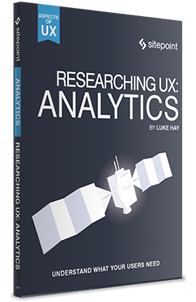How do you score your UX know-how?
If you were to rate your UX savviness, what would it be out of 5?
If I were to be completely honest with myself, I’d like to think that I know some UX, perhaps not a 5 but a comfortable 3?
So what happens when you’re discussing or testing usability with a client or boss? How does that conversation end, if you both have different ideas on best practice? You know some UX but your client/boss, on the other hand, knows the customer inside-out. Who wins? Unfortunately, this time it probably won’t be you (or me).
Why? Well because when making design decisions, it’s not just about aesthetics. If your design is not made perfectly (which it probably won’t be), you’ll find that your user flow needs some additional work. You’ll need to find a solution to your design that may not be that obvious to the naked eye without data.
If design is about the art, UX is the science behind the art, and there are real business impacts if either design and functionality are not well researched and user-centric. So the big question is, how do we move forward and detect pain points in our product? Data.
Having access to the right data means you can find blockages in your user flow, really get to know your users’ interactions and behavior, but most importantly find actionable solutions.
At this point you may be wondering, “which aspects of UX do I need to investigate?” Let me ask you:
- Are you gathering more than enough data behind your product or site?
- Do you know what to search for to identify pain points within your data?
- Do you know the advantages of analytical tools available and are you using them correctly?
- Can you make a direct correlation behind the bounce rates and your users’ engagement with your site?
- Are you accurately split testing changes and measuring results?
Yes, the entire process can be overwhelming, the numbers can be confusing, the data you collect may even be wrong. With so many uncertainties, how do we take the right steps forward?
We share what we learn from our experiences. We read and learn from a real UX trainer. We watch someone else work through their own process and pinpoint similarities and differences. Chat with everyone; UX professionals, colleagues, neighbors, friends. There are so many real life examples about where UX design went wrong — consider the lessons from those experiences.
Luke Hay has just released a book on this topic; Researching UX: Analytics. He believes that UX should give you the following 5 advantages.
- Analytics provides facts that are hard to argue with.
- Analytics gives fast results.
- Analytics offers unique insight.
- Analytics combines well with other UX methods.
- Analytics offers an effective way to present your findings.
I believe that they can too, but I guess it’s time for me to stop thinking and believing, let’s go out there and learn! If you’re like me and you’re not as UX savvy as you’d like to be, if you can’t completely correlate numbers to trends, behaviors, and potential blockages, what are you going to do about it?
Without data, you’re just another person with an opinion. — W Edwards Demming
A Solution — Researching UX: Analytics
I’m going to start by reading Researching UX: Analytics, a guide helping you learn how to make qualitative UX decisions driven by analytics. It’s a new book which we are very happy to announce has just been released, but we’re extremely proud of this book because it has been a topic that a portion of the staff have been discussing. It’s exactly what we’ve been looking for as we move into a focused and driven year ahead of us.
Within this 176 page book, you’ll learn about how you can use website and app analytics to make informed design decisions whilst your users’ have a positive experience. It will inspire you, it will guide you, and you will improve your understanding within the digital playing field (as well as your career objectives).
What’s Covered
- Why Analytics?
A look into why you should use analytics as part of your UX process. - Getting Set Up
This chapter dives into the technical side of things and make sure you have exactly the right analytical tools set up collecting the correct data. - An Introduction to Analyzing Data
Now that you’re all set up, we start digging into the data and explaining what it actually means. Learn about the different aspects of data analysis, keywords, interfaces and reporting (even with Google Data Studio). - Finding Problems with Analytics
You can only get so far with data if you can’t translate it to UX. In this chapter, we look at how to interpret the issues that data has highlighted. - Analytics for User Research
Here we look at how to analyze our users to get a true picture of the issues from a user-centric perspective. - Measuring and Reporting
Finally, in our last chapter, we’ll show you how to measure the success of our findings and report them.
Why This Book Is For You
In 175 pages, you’ll be able to absorb detailed, focused and actionable information on how to gather and interpret information that you can start putting into practice immediately. This book is not only for new UX professionals, it’s for designers, product managers and anyone interested in using analytical tools to help their project convert. If you’re curious about this book, have a read of our sample chapter.
The greatest value of a picture is when it forces us to notice what we never expected to see. — John Tunkey, American Mathematician
About Luke Hay

Luke Hay, a UK-based UX Consultant, prides himself in teaching the world about taking a user-centric approach to design, development, and optimization. When he’s not consulting he’s busy as the Senior Conversion Strategist at integrated digital agency Fresh Egg. If you’re in the UK, you can find him in his local digital community. He loves getting involved and has helped organize and curate events for UX Brighton, and is also one of the organizers of UX Camp Brighton.
Next Steps
- Read the sample chapter.
- Absorb everything from Researching UX: Analytics.
- Apply it into your next project and watch your UX credit skyrocket!
Next week Luke Hay, author of Researching UX: Analytics will be featuring in our live AMA on Google Analytics for User Insights. If you have UX questions, want to know more about how you can set yourself up with a data-driven workflow, or are having trouble uncovering data through Google Analytics, this is your chance to chat to Luke directly. It’s happening on Thursday, January 26th, 12pm (PST). See you there!
 Angela Molina
Angela MolinaAngela has been fascinated by and trawling the web since dial-up was the only way to connect. Now she's helping you learn (even more) as the Production Manager at SitePoint Premium.








